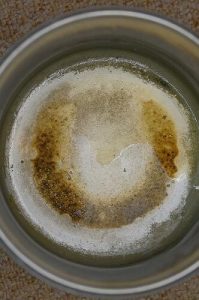The “interesting times” we’re hoping shortly to emerge from have given us cause to think earnestly about our life-styles. Devices to help us live cleaner, healthier lives are currently enjoying particularly—well—healthy sales. The pandemic has given us cause to question everything: about how we interact socially, how we travel, how we prepare our food. It has even cast doubt on the quality of water we drink.
Do you drink your water straight from the tap? If not, why? If so, should you?
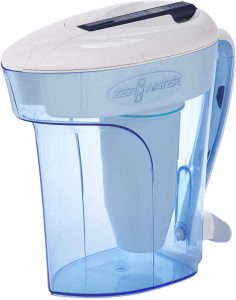 ZEROWATER IS A WATER FILTRATION SYSTEM that claims, as the name implies, to produce “the purest tasting water”. If you’re buying bottled water because you don’t trust what comes out of your tap, Zerowater has the answer. Its “unrivaled 5-stage ion-exchange filtration system” claims to remove 99.6% of anything that isn’t pure H20 to produce, in your home, the same level of purity as the very best bottled water.
ZEROWATER IS A WATER FILTRATION SYSTEM that claims, as the name implies, to produce “the purest tasting water”. If you’re buying bottled water because you don’t trust what comes out of your tap, Zerowater has the answer. Its “unrivaled 5-stage ion-exchange filtration system” claims to remove 99.6% of anything that isn’t pure H20 to produce, in your home, the same level of purity as the very best bottled water.
Sounds like an attractive proposition.
The Zerowater 2.8L Jug on review here is well-designed and practical. Nearly three litres of water is a heavy lift. But you don’t need the bicepts of a Bierkeller madchen as there’s an optional spring-loaded spigot at the base. Just three components, excluding the filter, comprise the system: The jug itself, the input reservoir and a click-to-fit lid.
There’s an important fourth component. We’ll get to that later.
The input reservoir is particularly ingenious.A large circular threaded hole in the centre accommodates the filter, which is screwed tight against its grommet. The input reservoir will hold about half a litre of tap water which takes its time to ooze down through the 5-stage filter into the jug. So you’ll have to refill the reservoir several times to get a full jug of water. In practice you’ll probably end up filling a glass with tap water, pouring that into the reservoir and then, by way of the spigot or the flap-covered spout, drawing off an equivalent glass-full of water that’s already been filtered.
The complexity of the filter means that water takes significantly longer than rival systems (like Brita) to pass through. To compensate for this, the sealed-off design of the input reservoir allows you to pour filtered water from the spout without spilling the tap water waiting to be processed.
Fiddling with Filters
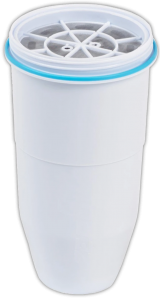 One crucial problem with changeable filters is knowing when to change them. If the filters are expensive (and Zerowater filters are), the tendency may to be leave them in as long as possible. And if the filter’s job is to remove substances which only marginally affect the taste of the water, if at all, it may be difficult to detect the point where they stop doing that job. And the very serious snag with depleted filters is that they can serve as an encouraging breeding ground for harmful bacteria.
One crucial problem with changeable filters is knowing when to change them. If the filters are expensive (and Zerowater filters are), the tendency may to be leave them in as long as possible. And if the filter’s job is to remove substances which only marginally affect the taste of the water, if at all, it may be difficult to detect the point where they stop doing that job. And the very serious snag with depleted filters is that they can serve as an encouraging breeding ground for harmful bacteria.
But depleted filters and harmful bacteria should never be a problem with Zerowater if the system is used according to instructions. The manufacturer has an elegant solution to this problem. Which is where the fourth component comes in. But first we need to know about TDS.
Total Dissolved Solids
The Zerowater filter is there to remove everything that isn’t water. This extra stuff is generically called TDS, or total dissolved solids. Tapwater in the jug’s input reservoir has TDS. This has all been removed when you pour water out of the spout or the spigot. That’s what Zerowater’s promotional bumpf tells me.
Do I trust Zerowater’s assurance?
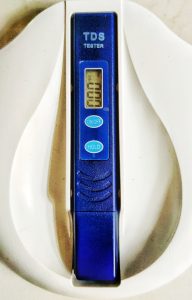
Well, I don’t have to. The fourth component that comes with the jug is a ready-to-use, battery driven TDS meter. With its probe submersed in water, its LCD screen gives me a reading of the parts per million (ppm) of TDS in the water.
These things are not expensive. Amazon will sell you one for seven quid. On eBay they’re four quid. AliExpress will do you one for half that price. Zerowater probably buys them in bulk for pennies. They’re a standard item based on very simple physics. Water passes electrical current in the presence of TDS and is close to being an insulator in its absence. The TDS meter is a simple ohmmeter. The higher the electrical resistance the lower the TDS content.
The Zerowater TDS meter clicks neatly into a slot in the lid of the jug, so it’s always there when you need it. You’ll be using it from time to time to make sure the filter is doing its job and also the check when the filter is depleted. The manufacturer suggests that a reading of 006ppm tells you it’s time to change.
It’s the Economy, Stupid
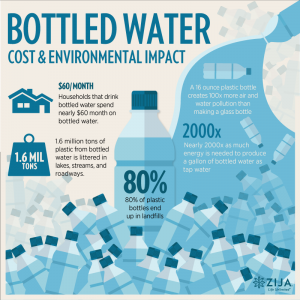
Plastic bottles of water have a planet-cost, not just because you’re hauling them home in the car or because the supermarket is transporting them in, often thousands of miles, by plane, ship and/or lorry. Each plastic bottle is an environmental threat in terms of it manufacture and disposal.
If you’re not feeling particularly warm and fuzzy about the planet it might be worth taking a look at the personal economic cost to you. Your kitchen sink delivers tap water for 0.1p per litre. The average price of a litre bottle of water is around 65p.
Your next questions will very likely be: So is it OK just to drink the tap water? And, if not, what’s the extra cost of running that litre of water through the Zerowater filtration system?
Zerowater’s publicity material suggests the respective answers are “Probably not” and “More expensive than inferior rival systems like Brita but affordable and worth it”.
The first question is especially interesting. But before we get into it, let’s pick up on that second question.
According to Zerowater’s figures, based on average UK tap water quality, a single filter will yield between 95 and 150 litres of purified water before the filter needs to be changed. Amazon’s price for a set of four replacement filters is £50, making the cost of a 150 litres of water (using their most optimistic figure) £12.50. That’s about eight pence a litre.
Quite a premium on the cost of water straight out of the tap. Eighty times more expensive. But only one-eighth the cost of bottled water.
Fishy Tales
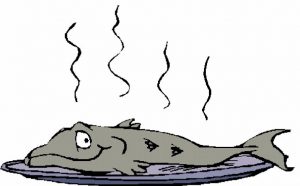 Those calculations are based on Zerowater’s own best-case figures. Some Amazon reviewers have come to different conclusions.
Those calculations are based on Zerowater’s own best-case figures. Some Amazon reviewers have come to different conclusions.
““, says one. ““ another claims. “,” a third reviewer writes.
Not very encouraging. I feel sympathy for these reviewers but their conclusions need to be approached carefully. Disgruntled customers are much more likely to opine than those who’ve found the product behaves as expected. And Tested Technology isn’t a review of Amazon reviewers’ reviews. Thanks to Zerowater’s donation, we have the product here to test for ourselves.
Our tap water here in London, UK, measures around 230ppm of TDS. After a month of use, the Zerowater jug is still delivering zero TDS. When it does finally reach 006 and the filter needs changing I’ll report back here.
It’s true that a slight fishy smell was evident within a couple of days of use. But it was coming from the input side of the filter, while the output water was zero TDS, completely odourless and drinkable. The smell from the input reservoir, only ever discernible when you lifted the lid, had entirely gone by the end of the week.
Tested Technology asked the manufacturer about this.
The fishy smell has a name: trimethylamine, or TMA. It’s closely related to ammonia and it’s a by-product of the action of one of the ion-exchange resins in the filter. Like ammonia, it can’t be described as harmless to humans. But during the time that it’s still only perceptible on the input side of the filter there will be no deleterious effect on the water coming out of the device—it remains Zerowater.
Eventually, yes, as the filter efficiency declines, TMA will start to be leached out into the output water. Initially evident as a slight lemony flavour, this tends to become fishier as the filter continues to deteriorate. The good news is two-fold: the potentially powerful odour and taste of TMA means that even beyond the stage where the water tastes and/or smells evidently unacceptable, the level of TMA will be far too low to be affect your health. You might say that because of the smell, TMA carries its own health warning.
The second part of the good news is that the TDS meter will detect the need for a filter-change well before this point. As long as you check the output water with this device sufficiently often (every five or so extracted litres, perhaps), dead fish should never enter the equation.
The WasserDalek—Another Road to Zero
If you want to strip everything out of your tap-water that isn’t water, the simplest approach may be to boil it. Does that sound convincing to you?
It shouldn’t.
Yes, boiling the water will get rid of chlorine by evaporation. It will also deposit some of the calcium on the inside of your kettle as limescale. But the TDS of our London tap water typically only drops around ten points after boiling. Bacteria, if any, won’t have survived. But any heavy metals will still be there.
However, boiling is the way we’ve been producing pure water here at Tested Technology Towers for over a year now. Water with zero TDS is invaluable for steam ironing and is also part of the process that keeps our Fracino Piccino espresso machine chortling away. (I’ll explain why it’s only part of the process later.)
So how do we get zero TDS by boiling? We boil all the water off as steam and condense the steam. In a word, distillation.
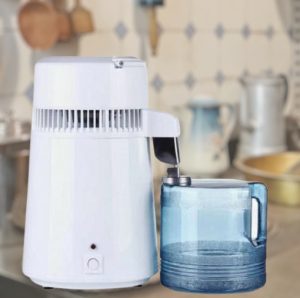
*Water Dalek. because that’s what it looks like. Although it’s made in China (what isn’t?) the German name seems to fit.
Our water distiller, affectionately known in the household as the WasserDalek,* is effectively a deep electric saucepan with an airtight lid. This lid, the head unit, incorporates a spiral of metal tubing cooled by an electric fan. The engineering is as simple as it could possibly be, with no electronics, only a heating coil with a mechanical thermal cut-off and a simple electric motor and fan.
You fill it with four litres of tap water, assemble the head unit and switch it on. The water boils, the head unit condenses the resulting steam and out comes nothing but water. There’s just one other element. As chlorine and any other fluids with a higher boiling-point than water will also be carried over with the distillate, the head unit incorporates a small replaceable active carbon “teabbag” that the output drips through on its way into the 4 litre receptacle.
The WassenDalek takes about three and half hours to produce four litres of distilled water. It’s a 800W device, so the total juice use for this distillation is 2.8KWh. At, say 14p per KWh, that’s a cost of just about 10p per litre.
So Zerowater appears cheaper but within the boundaries of my approximations it’s probably much of a muchness. Other factors are:
- The WasserDalek is considerably slower. We call its output WasserDalekTränen (Tears of the Water Dalek) because the distillate emerges drop by drop.
- The WasserDalek needs to be cleaned afterwards (actually, no big deal—see below).
- Capital cost.
The capital cost may surprise you. The design of the WassenDalek, though simple, is obviously many times more complex than the Zerowater’s plastic jug, where the clever stuff is all in the replaceable filter. Fundamentally identical versions of our water distiller are on the market for prices up to around £500. The top end versions will have stainless steel outer casings and will come with a glass receptacle, but the internals will be indistinguishable from our WassenDalek, which has a white plastic casing and a transparent polypropylene receptacle. We bought it on AliExpress for around £30. Ten pounds cheaper than the Zerowater.
You should be able to find water distillers for fifty pounds or so on Chinese Websites, but delivery can easily more than double the price. We were very lucky to find one in a sale from a UK AliExpress vendor who was offering free delivery. UK vendors are typically charging around £150 for plastic-cased models and £200 for stainless steel casing. The working parts of all these types will be very similar—all, for example, having a durable stainless steel boiling vessel.
Wattages do differ. Ours is on the high side at 800W, producing four litres in less than four hours. Lower wattage devices will take longer—up to six hours. A useful tip is to start with water from the hot water tap.
It may be getting too late to snap up Chinese water distillers at super-low prices. The components—electric heating coil, thermal cut-out, fan motor—are widely used standard parts (so cheap and easily repairable) but shipping costs have more than doubled since we bought ours.
Cleaning the WasserDalek
The Internet is awash with frightening photos of the disgusting insides of a water distiller after it’s done its job. “Foul-smelling brown scum you would otherwise be drinking” would be a typical caption used by pure-waterists.
To put it mildly, you’re being misled. What you’re seeing is mostly the same sort of harmless calcium deposit you would get inside a kettle but cooked to a crisp. The cooking happens because the thermal cut-off only kicks in several seconds after the water has boiled completely dry.
If there were lead, radium, strontium 90 or plutonium in the water, that would be left behind in the brown gunge too. But those heavy metals will not be in regular UK tap water. These things are well regulated. If these noxious substances were there (and, of course, you’ll find Internet pages confident of this as a fact), your family distiller or ion exchanger would be no more than an umbrella under an avalanche. The poisoning would be threatening your entire neighbourhood.
The one problem with the baked in brown deposit is that its tough to clean. But this is completely avoidable it you add a cheap electronic timer between your mains outlet and the distiller power plug. We regularly fill the distiller slightly above the Full line and set the timer to a few minutes short of the boil-dry time. The distiller will then switch off before it boils dry, leaving a quarter of an inch of chalky water which is easily rinsed away.
This makes it possible to run four sessions one after another. Sixteen litres in a single day. At the end of which a whiteish deposit inside the stainless steel boiler has to be cleaned out. All that’s required is to rinse out the chalky residue, add a new quarter inch of tap water and sprinkle in citric acid crystals.
The water may need briefly bringing to the boil again, depending on the extent of the deposit. Then switch off, leave it to stand for ten minutes, use a soft scrub sponge to wipe down the inside walls of the boiler and the whole machine is clean and ready to store away until next time.
Mineral Myths?
But don’t I need those minerals?
Yes and no. Yes, because there’s no question that many of the minerals that ion-exchange and distillation take out of your drinking water are essential to life. No, because those essentials like potassium, sodium, calcium and to some extent selenium, have already been pulled out of the ground by the vegetables you eat. The vegetables will have conveniently packaged them for your digestion in much greater quantities than your water intake can provide.
The conventional wisdom is that deionised or distilled water is harmless. Not especially amazingly good for you nor—as some hysterical Internet reports claim—particularly dangerous.
For a personal view of the dietetic dangers of distilled water, this is worth a read. But take it with—as you might say—a pinch of salt.
I especiallly enjoy the myth, evidently promoted for the benefit of credulous visiting journalists by bored technicians at the Japanese Super-Kamiokande particle detector, that the super-pure water used to capture the paths of neutrinos is “so pure that it’s more like an acid and an alkaline than the H2O we know…”.
This story, appears in various forms on the Internet, with a wrench dropped into the tank in error “dissolving, leaving only its outline” or a chrome plated hammer “eaten away with only its chrome shell remaining”. Pure water is described as “having a pH half-way between caustic soda and sulphuric acid” and therefore (?) “sharing the properties of both these highly toxic substances”.
Pure rubbish? Almost entirely. However, one valid caveat about drinking too much “pure” water has emerged from the WHO. According to this paper there is a tendency for artificially-produced demineralised waters to leach out salubrious minerals from the body. That goodness from the vegetables gets washed out when you drink, for example, too much Zerowater.
Remineralisation
At Tested Technology Towers we divide the WasserDalekTränen into two batches. Around a third is put aside for ironing; the two-thirds that goes into the Piccino expresso machine is given extra treatment. It gets remineralised. And we will do the same for any Zerowater that goes into the machine.
This isn’t because we drink so much coffee that we need to implement anti-leaching measures. It’s because water with a TDS of around zero won’t work in the machine. Fill its reservoir with Zerowater or WasserDalekTränen and the boilers refuse to boil and an alarm will start to beep.
In common with many other hot beverage machines, the water level is monitored not volumetrically but electrically. Electrodes in the reservoir continuously pass a tiny current through the water to make sure it’s there—effectively an elementary TDS meter. The flow of electrons is dependent on free ions in the water, ions provided by the TDS. Remove the TDS and water is in fact an excellent electrical insulator. No current flows.
There’s one other reason. Good coffee needs good water. One of the downsides of denatured water mentioned in the WHO report is the fact that it has, as they politely put it, “poor taste characteristics”. It’s a matter of, er, taste, of course. But most people drinking distilled or de-ionised water for the first time will find it strangely flat. Missing something. The taste of water, from the tap, from the manufacturer’s bottle or fresh from the spring, is all down to the TDS.
So for both these reasons we add back minerals. Specifically sodium and magnesium. To get what you might call the “proper taste” and certainly for the optimal health mix, we should also chuck in calcium. But removing the calcium is the main point of running the water through the WassenDalek, because it’s calcium that builds up as limescale inside the Piccino’s dual boilers.
Following exhaustive Internet research (well, it certainly exhausted me) I settled on using only sodium bicarbonate and magnesium sulphate. Both are very cheap and easily obtainable, as is the crystal citric acid used to clean the WassenDalek.
The simplest way of thinking of this is as a process of “re-hardening” the water. Water hardness (so-called because of its effect on soap) has two separate measurements, GH and KH.
GH stands for “General Hardness”, a measurement of the total amount of calcium and/or magnesium ions in the water. KH is short for “Karbonathärte”, which is German for carbonate hardness, the kind associated with the presence of bicarbonate ions.
Here’s the formula I settled on:

The double-dilution process
The pink “Made up from” row is the number of grams of the pure GH or KH to be added to distilled water to make up the intermediate mixture.
The blue “Add to 4 litres” row is how much intermediate mix to add to four litres of distilled water for the final mineralisation.
Please report back here if you’ve reason to believe otherwise but it’s my understanding that tap water in the UK and throughout the developed world is harmless and drinkable. As I’ve said, if this isn’t the case, the problem will be much bigger than just your household taps and the solution should be scaled accordingly, not just band-aided with a gizmo like the Zerowater or the WassenDalek.
These devices make sense to prevent limescale in domestic machines like steam irons or espresso makers, with appropriate remineralisation for the latter. We originally used the WassenDalek for our tea-kettle until realising that the same citric acid we were using to clean the distiller very easily fixed the visible and accessable limescale build-up in the kettle. Citric acid wouldn’t be a good idea for the more complex internal plumbing of the Piccino.
Should you be drinking denatured water regularly? Amazon reviewers (not those in the fishy-smell camp, obviously) have praised the “pure, clean taste of Zerowater”. We don’t share this view. Blind taste tests between fridge-cooled tap water and Zerowater (or unremineralised WassenDalekTränen) at the same temperature leave us preferring the former every time.
And there are the health considerations. In the words of the WHO report cited above: “Demineralised water that has not been remineralised… is not considered ideal drinking water, and therefore, its regular consumption may not be providing adequate levels of some beneficial nutrients.”
In Conclusion (but To Be Continued)
There’s much more to be said on the subject. We’d like to hear back from readers about their own tap water while we continue to test the Zerowater jug and make more accurate estimates of the cost of its output per litre. This question of the effect of distilled or ion-exchanged water on the human body also needs further investigation.
Meanwhile, the Zerowater 2.8L Jug is an ingeniously designed and well-built device that, with proper maintenance, can reliably provide zero TDS water. Despite the apparently high price of the filters, the cost appears to be the same or slightly less than distilled water from a domestic distillation device. It is certainly a great deal cheaper than equivalent bottled drinking water from commercial manufacturers.
On the basis of capital cost and running cost, it seems that our WassenDalek runs neck-and-neck against the Zerowater 2.8L Jug. But it’s doubtful if readers can still obtain a water distiller at the low price we paid for the WassenDalek. Depending on how long the Zerowater filters last (which will be part of our ongoing investigation) and bearing in mind its much simpler maintenance, the £40 Zerowater 2.8L Jug looks like the better bet for most domestic applications.
Chris Bidmead
.

